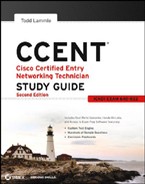Chapter 10: Introduction to Wide Area Networks
- C, D. The two authentication methods built into PPP are CHAP and PAP.
- C. If you have only one free serial interface on your router, you can use Frame Relay to connect multiple remote sites using PVCs (subinterfaces).
- A, B, C. ISDN is considered a layer 3 WAN technology and is completely outdated. Cisco considers PPP, HDLC, and Frame Relay the most common WAN technologies.
- B, C, E. Leased lines, circuit switching, and packet switching are the typical WAN connection types.
- B. You cannot use the no encapsulation command on a serial interface. To enable a certain encapsulation or to change to a different encapsulation type, use encapsulation ppp, for example.
- C, D, E. Ethernet is a LAN technology and cannot be configured on a serial interface. PPP, HDLC, and Frame Relay are layer 2 WAN technologies that are typically configured on a serial interface.
- A. Cisco, as do most router vendors, uses HDLC as the default serial encapsulation, but remember that each vendor uses a proprietary HDLC.
- A. Clocking on a serial interface is always provided by the CSU/DSU (DCE device). However, if you do not have a CSU/DSU in your nonproduction test environment, then you need to supply clocking with the clock rate command on the serial interface of the router with the DCE cable attached.
- C, E. High-Level Data-Link Control (HDLC) was derived from Synchronous Data Link Control (SDLC), which was created by IBM as a Data Link connection protocol. It is unlikely that two different vendors' routers will communicate because of a proprietary LLC layer. Option A is wrong because the Type field is used in an Ethernet frame, not a serial encapsulation; option B is wrong because you use the clock rate command only in nonproduction networks; and option D is wrong because you don't have user-names or authentication with HDLC.
- A, C, D. When PPP connections are started, the links go through three phases of session establishment: link establishment, the authentication phase, and the Network layer protocol phase.
- C. This question is looking for today's typical connection type, which would be an Ethernet connection to a router and then a serial interface to the Internet. Certainly there are other options, but option C is the best answer to this question.
- D. PPP is your only option because HDLC and Frame Relay do not support these types of business requirements. PPP provides dynamic addressing, authentication using PAP or CHAP, and callback services.
- B. A packet-switched technology that emerged in the early 1990s, Frame Relay is a Data Link and Physical layer specification that provides high performance.
- B. PPP has a three-phase setup when you bring up a data link using PPP. These are session setup, optional authentication, and the network layer protocol phase.
- E. This is an easy question because the Remote router is using the default HDLC serial encapsulation and the Corp router is using the PPP serial encapsulation. You should go to the Remote router and set that encapsulation to PPP or change the Corp router back to the default of HDLC (assuming both routers are Cisco routers).
- B. Since each subnet mask is a /24 (255.255.255.0) and the IP addresses are Class C, each IP address is in its own subnet. The two interfaces will never communicate.
- B. Router interfaces are, by default, data terminal equipment (DTE), and they connect into data communication equipment (DCE)—for example, a channel service unit/data service unit (CSU/DSU). The CSU/DSU then plugs into a demarcation location (demarc) and is the service provider's last responsibility. Most of the time, the demarc is a jack that has an RJ-45 (8-pin modular) female connector located in a telecommunications closet.
- B. The version of HDLC as implemented on a Cisco router is Cisco proprietary, and you cannot have HDLC on one side of a link and any other version of HDLC on the other side of the link. Nor can you have HDLC of any type on one side and PPP or Frame Relay on the other.
- C. LCP provides a method of establishing, configuring, maintaining, and terminating the point-to-point connection. At start-up, LCP provides link establishment.
- A. Digital subscriber line is a technology used by traditional telephone companies to deliver advanced services (high-speed data and backward-compatible to analog video) over twisted-pair copper telephone wires and is backward-compatible with analog voice.
..................Content has been hidden....................
You can't read the all page of ebook, please click here login for view all page.
